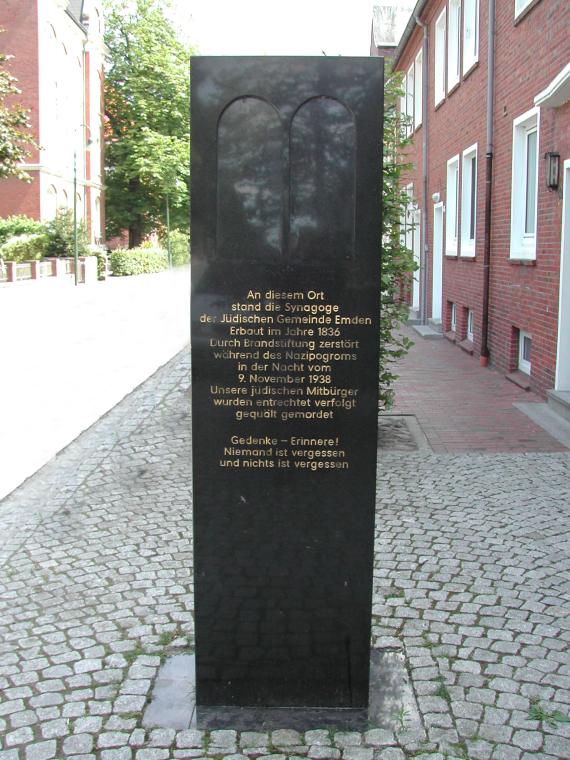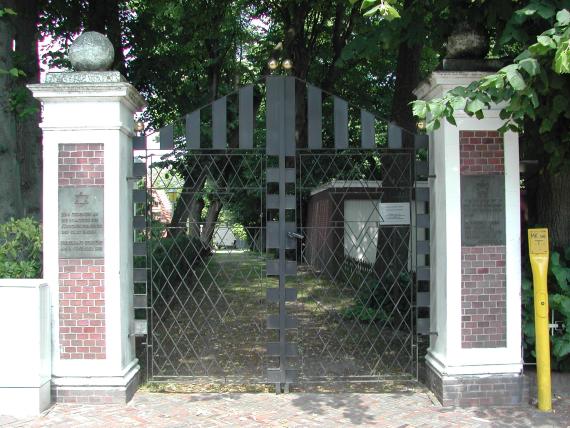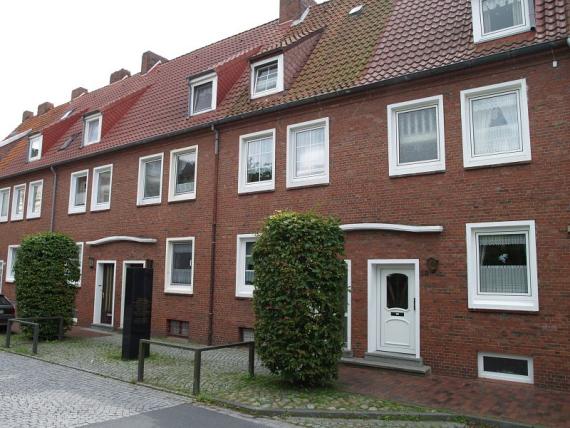Bollwerkstraße
26725 Emden
Germany
In Emden there was a Jewish community until 1938/40. Its origin goes back to the time of the 16th century. According to old, historically not provable legends there should have been Jewish women*Jews in the city already in the antiquity. Already after the destruction of Jerusalem by Titus (70 AD) Jewish prisoners are said to have been put ashore in Emden. According to the Frisian historian Eggerik Beninga (1490-1562; Chronik van Oostfriesland. E. 1723), a number of Jewish families are said to have come to the North Sea coast in East Frisia as early as after the destruction of the first temple by Nebuchadnezzar.
It can be assumed that there were Jews*Jews in the town for the first time - possibly only temporarily - in the 14th century, but there is no documentary evidence from the entire period of the Middle Ages.
Since 1571 there is evidence of Jews in the city, but the first settlements were probably a few years earlier; according to various (later sources) there were Jews in the city since about 1530. The first Jewish families were of Ashkenazi origin, only later (after 1649 at the earliest or around 1700) and only in 1712 there were also some Sephardic Jewish families (Portuguese Marranos) in Emden. A first Schutzgeldverzeichnis exists from the year 1589 (six 'German' Jewish families). Initially, the Jews of the town were under the protection of the East Frisian count's house, at the beginning of the 17th century the protection of the Jews was transferred to the town.
In 1613 there were 16 Jewish families in the town, in 1624 21 families; by the middle of the 18th century the number increased to 98 families (1741). From Emden there were first emigrations to America already in the 17th century; in 1696 Abraham Isaack from Emden played an important role in building the only synagogue in New York at that time. In the second half of the 18th century, the highest proportion of Jewish inhabitants in the total population was reached (in 1771, 7.6% of the population were Jewish).
The Jewish community in Emden also included Jewish families living in the vicinity of the city (Greetsiel, ldersum, Pewsum, Rysum, Wirdum, Woquard).
Emden was the seat of a rabbi as early as the 17th century, and from 1827 to 1939 the seat of a regional rabbi, initially responsible for the Jewish communities in East Frisia, and in the course of the decades for the Jewish communities in the wider area. The first rabbi known by name, Uri Halewi (= Philips Joost/Feibisch Emden, ca. 1540-1620/25), came to East Frisia after the expulsion of the Jews from Brunswick (had been in Amsterdam since 1602). In the 18th century the most important rabbi in the city was Jakob Emden (1697-1776), who was rabbi in Emden for three years from 1729.
The Jewish families were able to pursue their economic and trade relations very freely in the 17th/18th centuries under the protection of the magistrate. They were allowed house and land ownership. There were hardly any restrictions on immigration. However, the number of wealthy Jewish families always remained small (about 10% of the families). About two thirds of the community members - mostly families of junk dealers and butchers - belonged to the lower class of the Jewish community. It was not until the takeover of East Frisia by Prussia in 1744 that the situation of Jews in the town deteriorated significantly. Towards the end of the Seven Years' War (1756-1763), riots against Jews occurred for the first time in connection with the poor economic conditions during the war.
In the 19th century the number of Jewish inhabitants developed as follows: 1804 490 Jewish residents (4.4% of a total of 11,128 residents), 1828 802 (6.7%), 1848 730 (5.7% of 12,727), 1861 758 (6.2% of 12.139), 1871 681 (5.4% of 12,588), 1885 663 (4.7% of 14,019), 1895 726 (5.0% of 14,485), 1905 809 (3.9% of 20,754).
In the first half of the 19th century, the Jüdinnen*Juden in Emden still had to contend with numerous legal restrictions. The Ministry of the Kingdom of Hanover wanted to reduce the number of Jews in Emden and East Frisia through various measures. As a result, the number of Jewish residents declined from 1828 (802) to 1842 (691). It was not until the 1840s that the situation of Jews in the city improved again: in 1843, the first Jewish residents officially became Emden citizens; by 1852, a total of 46 Emden Jews had been granted citizenship. In the first half of the 19th century, the majority of Emden's Jews still made a living from small-scale and junk trading, from small-scale money transactions on pawns, from the livestock trade and from the butcher's trade. Since the middle of the 19th century there were also Jewish craftsmen and academics (doctors like Dr. Carl Joseph Norden, Adolph Leers, lawyers and others).
Facilities included a synagogue (see below), a Jewish school, a ritual bath and a cemetery. In addition to the rabbi, several religious officials (teacher, prayer leader, shochet) were usually employed to perform religious duties for the community. In 1843/45 a three, later two-class community school was built in Judenstraße next to the synagogue. In 1858 three teachers of the community taught at this school (cf. job advertisements in the text page).
The following were killed in action from the Jewish community in World War I: Jonas de Beer (b. 27.2.1892 in Emden, killed 17.9.1916), Ludwig Fulde (b. 7.1.1889 in Emden, killed 27.6.1915), Harry Gans (b. 15.8.1895 in Emden, killed 18.4.1917), Sergeant Arnold Italjener (b. 1.4.1893 in Emden, killed 30.7.1918), Richard Koppel (gen. 15.12.1897 in Pewsum, gef. 14.10.1917), Jakob Seligmann b. 2.6.1898 in Emden, gef. 21.3.1918), Jakob Valk (b. 6.10.1882 in Emden, gef. 2.3.1917), Salomon Visser (b. 22.4.1889 in Emden, gef. 13.7.1917), Max Windmüller (b. 9.10.1886 in Emden, gef. 21.2.1915). Also fallen: Iwan Pels (b. 25.5.1890 in Emden, living in Herne, Westphalia before 1914, gef. 19.1.1915).
Around 1925, when the community included about 700 people (about 3% of a total population of 30,000), the community leaders were Jacob S. Pels (resides Kettenbrücke), Philipp Meyer, S. Nordheimer and Rendant Gottschalk. The representation included: Hermann Hartogsohn, S. H. Schönberg, Wolf Balk, Katzenstein, Max v.d. Walde, S. v.d. Wyk, Arnold Visser, Louis ten Brink and Louis Pels. Landrabbiner S. Blum had his seat at Judenstraße 43. Joel Hes served as cantor and shochet, likewise B. Schwarz. The Jewish elementary school was attended by 60 children, the head was teacher B. Apt, the other teacher was Julius Gottschalk. 40 Jewish pupils in high schools received their religious education at the Jewish elementary school.
In 1932, four people formed the community board: Louis Wolff (1st chairman, living Kleine Faldernstraße), Max v.d. Walde (2nd chairman), Hermann Seligmann (3rd chairman). The representative body included nine community members under the chairmanship of: Hermann Hartogsohn (1st chair; lives Okkotombrokstraße), L. ten Brink (2nd chair), Simon Pels (3rd chair, lives Am Bollwerk). The community council had a building committee (chairman Louis Wolff), a synagogue committee (chairman Max v.d. Walde) and a tax committee (chairman Hermann Seligmann). Furthermore, the Landrabbiner was Dr. Blum; the head cantor in the meantime was I. Wolkenfeld (living at Kl. Osterstraße 39), cantor S. Igler (living at Judenstraße 40). The Jewish elementary school was attended by 61 children (2 classes); religious instruction was given to 80 children. The principal was teacher S. Hirschberg (lives at Zw. bd. Sylen 2), the other teacher was Julius Gottschalk.
An Jewish institutions existed
.
- the Jewish Orphanage (Esrath Jessomim) with 24 places, 12 girls and 12 boys each (founded in 1886; Claas-Tholenstraße; 1924 chairman Landrabbiner Blum; director: Emil Zielinsky; acceptance of orphaned school-age children and those lacking suitable home education; for social hardship cases from the rabbinate district of East Frisia-Osnabrück there were also exemptions) as well as
- the Israelite asylum for the Aurich and Osnabrück regional rabbinate district (Machseh Loewjaunum, founded in 1879; old people's home, Schonhovenstraße 8 with 8 places (4 male and 4 female); sponsor: Asyl-Verein, 1924 under the chairmanship of Jabob Pels; management of the asylum: Frau Bundheim [widow of Simon B.] ).
The Jewish community of Emden also included Jewish persons living in surrounding towns: in Oldersum (23 persons in 1924; head of the branch was S. Cohen; 9 in 1932), in Woquard (5 persons in 1924, 2 in 1932), and in Wirdum (6 persons in 1924. 2 in 1932).
The following Jewish associations existed: the Israelitische Kranken- und Beerdigungsbrüderschaft e.V. (founded in 1661, 1924/32 under the chairmanship of Moritz v.d. Berg (Ulrichstraße 17), W. D. d. Beer and M. Löwenstein with 180/200 members; goal and field of work: nursing, burial) the female Kranken- und Beerdigungsverein (1924 under the leadership of Mrs. B. Selig, Edzardstraße 19, Mrs. S. Gossels and Mrs. Is. Gossels; the Esches Chajil Association (founded in 1848; in 1924 headed by Mrs. B. Selig, Mrs. B. de Leuw and Mrs. G. Gossels, in 1932 headed by Mrs. de Leuw with 110 members; purpose and fields of work: Nursing, vocational training for needy girls and women), the Verein für durchreisende Arme Hachnossath Orchim e.V. (founded in 1846; purpose and field of work: for poor people traveling through / itinerant welfare; 1924/32 under the direction of J. Gans [Kleine Faldernstraße 14] and L. ten Brink with 91 members), the Knabenverein Derech Z'dokoh e.V. (founded in 1860, headed by Louis Wolff, Leo Sternberg and teacher Julius Gottschalk in 1924; headed by teacher Gottschalk [Wallstraße] in 1932; purpose and field of activity: Passover provision, youth welfare); the Jewish Youth League (literary and sports club; headed by Julius Gottschalk in 1924; headed by Ida Polak [Neutorstraße] in 1932); the Club of Jewish Girls (headed by Frieda S. Falk, not named in 1932); the local group of the Agudas Yisroel youth organization (1924/32 headed by Jacob v.d. Walde); the local group of the Brith Haolim (1924 headed by Isi Falk, not named in 1932), the Israelitische Mäntelchen-Berein (Bigde S'rod; 1924 headed by Mrs. Phil. Meyer and the wife of Landrabbiner Blum; in 1932 headed by Fr. Polak), the Talmud Torah Association (1924/32 headed by Landrabbiner Dr. Blum and Ph. Meyer with 44 members), the Moaus Laewjon Association (1924 headed by Is. v.d. Walde and Is. Fulda with 15 members, not named in 1932), the Verein Malbisch Arumim e.V. (founded in 1900; 1924/32 headed by Lazarus Nordheimer, Mos. v.d. Berg and Jac. Gans with 21/19 members; purpose and field of work: clothing of needy people), the association Hachnossat Kallo e.V. (founded in 1811; 1924/32 under the leadership of Lazarus Nordheimer, Fr. Isr. Hartogsohn, Is. Seligmann, H. von Cleef, Abr. Weinberg with 40 members; purpose and field of work: bridal equipment), the association Orach Chajim (1924 under the leadership of Phil. Meyer and Jac. Pels), the association Bachure Chemed e.V. (founded 1800; 1924/32 under the leadership of Lazarus Nordheimer [Alter Markt 12] with 14/9 members; purpose and field of work: providing for the needy on Passover), the association Roeh Simchah (1924 under the leadership of H. v.d. Walde, Viktor Gossels and Valk with 15 members), a local group of the Centralverein (1924 headed by Dr. Sternberg [Gr. Brückstraße] and Hermann Seligmann; 1932 headed by Hermann Seligmann, a local group of the Reichsbund jüdischer Frontsoldaten (1924 headed by Arnold Visser with 45 members; 1932 headed by Leo Sternberg), a Zionist local group (1932 headed by Dr. Kretschmer).
The charitable associations (in 1932 eight of the above-mentioned associations) worked together in a "Local Center for Jewish Welfare - Working Group of Welfare Associations (1932 chaired by Moritz v.d. Berg [Ulrichstraße 17]; purpose and field of work: federation of welfare work).
In 1933, 581 Jewish people lived in the city (out of a total population of 34,111). In the following years, part of the Jewish community members (until 1938 about a quarter) moved away or emigrated due to the consequences of the economic boycott, increasing disenfranchisement and reprisals. As early as the night of March 28-29, 1933, numerous shop windows of Jewish stores were smashed by SA men. At the beginning of 1934, windows were broken by Emden residents who still shopped in Jewish stores. In 1935, Jews were forbidden to visit the municipal baths. By 1937, a total of 47 Jewish businesses, houses and properties were sold to non-Jewish persons. By 1938/39, all Jewish businesses had been forcibly closed or sold. On September 1, 1938, 430 Jewish residents were still counted. At the end of October 1938, five East Jewish families (24 persons) were forcibly expelled to Poland. During the November pogrom of 1938, the synagogue was burned down. Jewish families were taken from their homes; men, women and children were abused, insulted and mocked. Jewish stores were demolished and looted. Most of the Jewish men were arrested and taken to Sachsenhausen concentration camp and held for weeks, among them was Rabbi Blum. On November 8, 1939, 320 Jewish residents were still counted (out of a total of 34,786). In February and March 1940 almost all Jewish inhabitants had to leave Emden. They were "resettled" in other larger cities, crowded into Jewish houses there and conscripted into forced labor.
Of the Jewish persons born in Emden and/or living there for a long time, many perished during the Nazi era- A compilation of the names cannot be made here, cf. the data of the "Memorial Book - Victims of the Persecution of Jews under National Socialist Tyranny in Germany 1933-1945") with entry of "Emden" as place of birth: 361 names; "Emden" as place of residence: 383 names; a total of 528 names (deducting those who were born in Emden and still lived there in 1933ff). According to the "Historical Handbook" (see lit.) the names of 465 murdered Jews from Emden are known, who either had lived here in 1933 or in the years before or who had moved to Emden during the Nazi period, partly under duress. These 465 names are on a monument inaugurated in 1990 in the Jewish cemetery.
After 1945, only a few former Jewish residents who had survived the Nazi period returned to Emden. In 1949, a new synagogue congregation was founded as an association. The association existed until 1984, when it had only one member. Since then, the few Jewish inhabitants of Emden have belonged to the Oldenburg synagogue community.




Add new comment